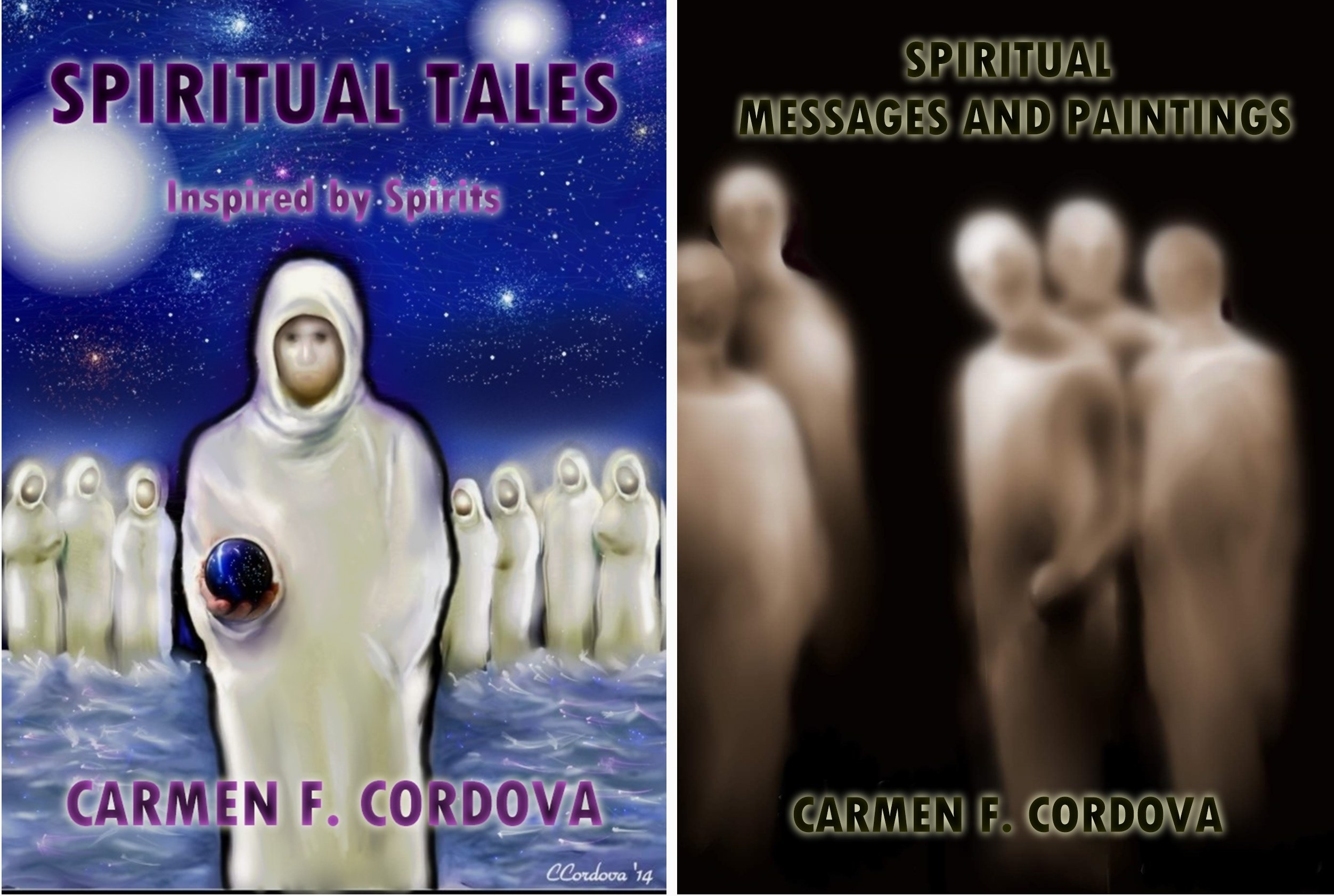Native American Spiritual Beliefs
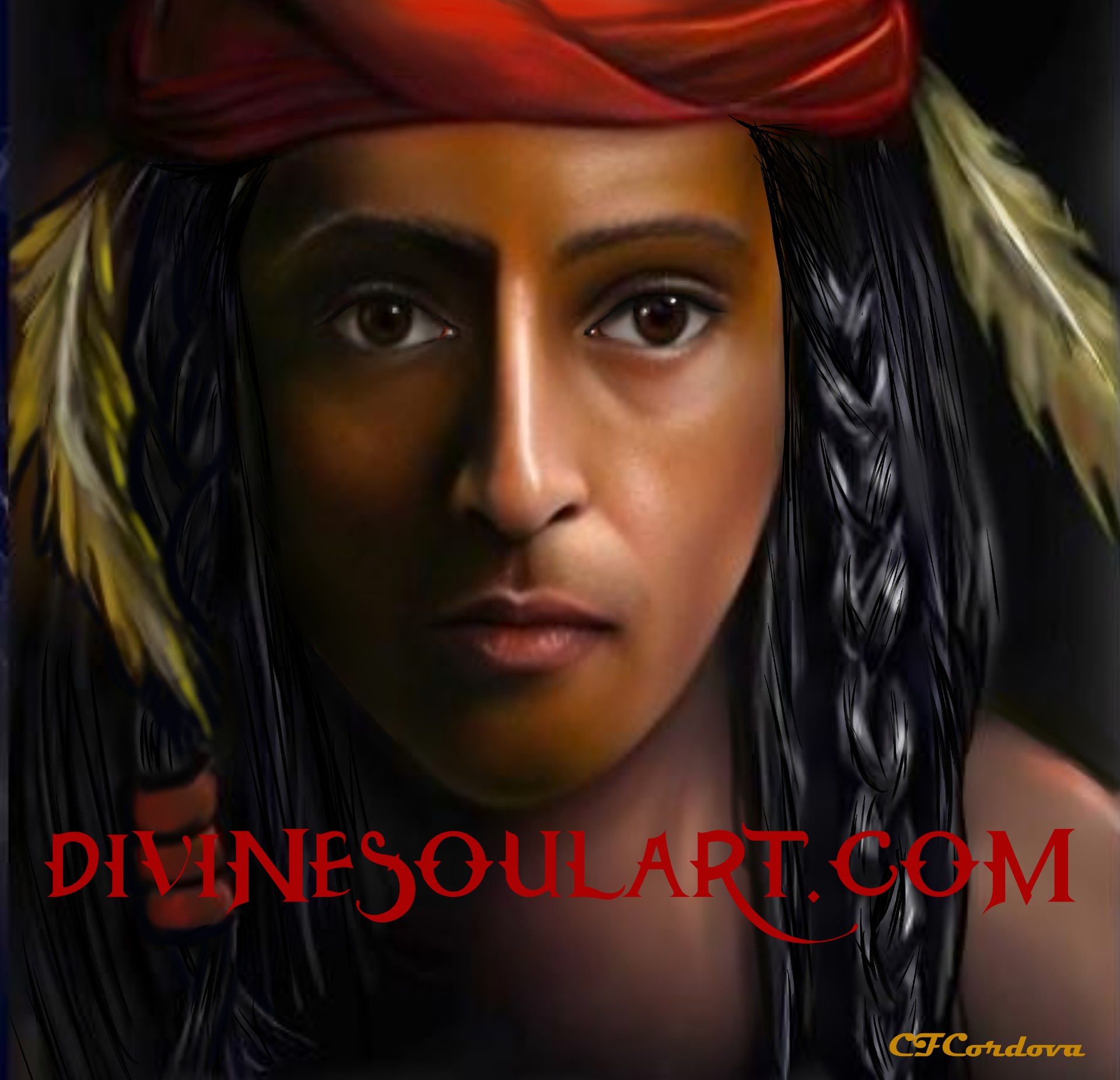 North American Indian
North American IndianNative American history, particularly in its spiritual aspects, is a rich tapestry of traditions and practices. While these beliefs vary among tribes, they often underscore a profound connection with nature, the Great Spirit, and the importance of maintaining harmony within the spiritual realm. This article explores the main concepts, deities, rituals, and the spiritual importance of animals in Native American spiritual beliefs, traditions and practices, among other topics.
Core Concepts of Native American Sacred Beliefs
Native American spirituality encompasses a rich range of beliefs and practices, with each tribe offering its own unique traditions. These spiritual teachings are deeply tied to cultural legacy, fostering a strong sense of identity and continuity. Central to many tribes are creation myths—sacred stories that explain the origins of human beings and the natural world. These stories carry sacred power and guide the spiritual journeys of indigenous communities.
The phrase “Mitakuye Oyasin,” meaning “we are all related,” encapsulates the central concept of interconnectedness in American Indian spirituality. As emphasized by tribes like the Lakota, this concept highlights the interdependence of all living things, fostering unity and respect for nature. These beliefs highlight the importance of maintaining balance and harmony within the spirit realm, reflecting the deep respect American Indians have for both nature and the cosmos.
Each tribe's spiritual practices and religious tenets are unique and influenced by its specific history and environment. However, they share common themes of gratitude and recognition of the spiritual beings that inhabit their world. This diversity within unity emphasizes the rich history and spirituality of Native American tribes, with each group's traditions and rituals contributing to a greater understanding of spirituality as a whole.
The Role of the Great Spirit
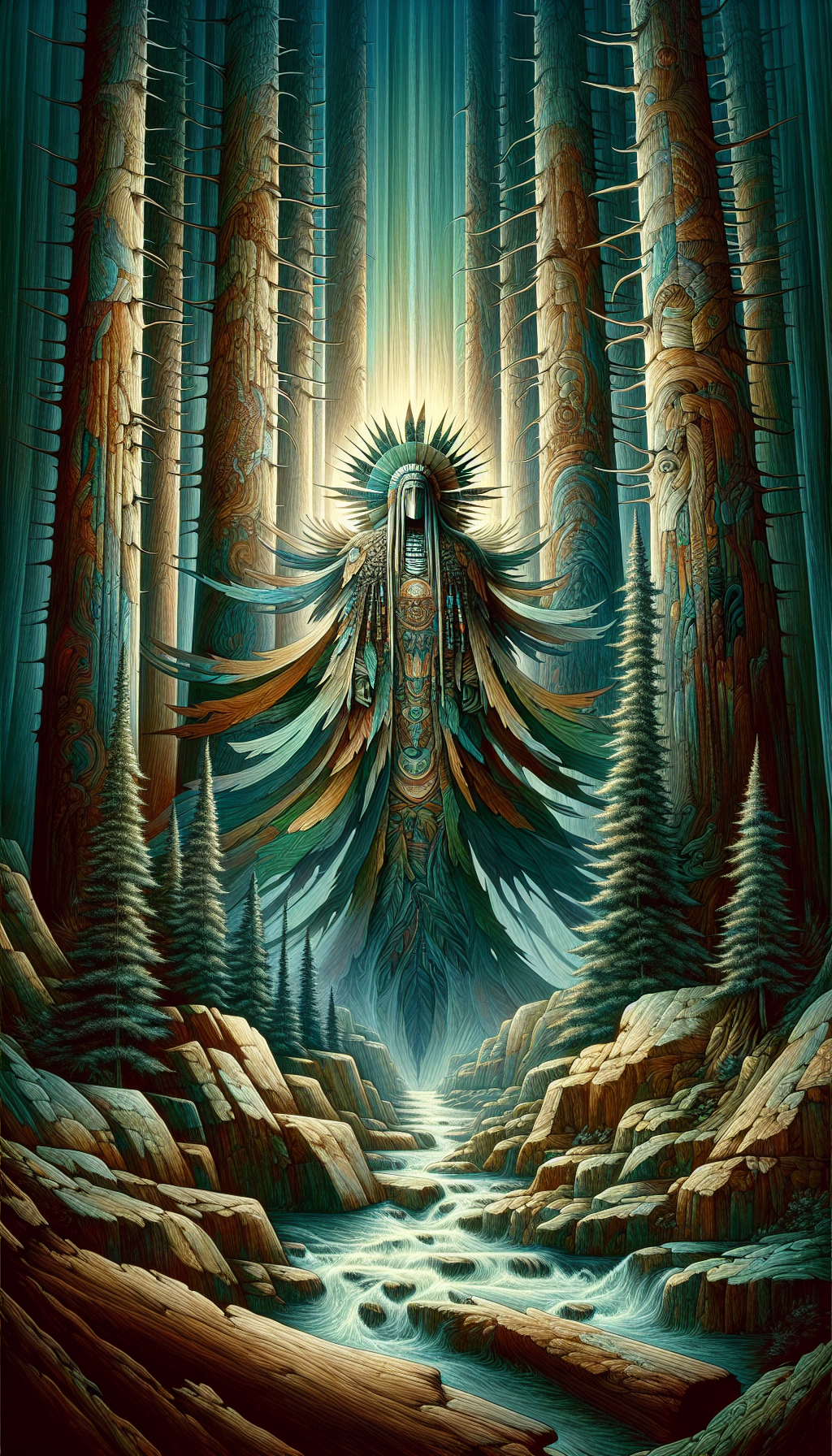 Native North Americans - Supreme Being
Native North Americans - Supreme BeingAccording to Native American history, the Great Spirit is more than a distant deity; it is a guiding force in everyday life. In Haudenosaunee tradition, the Great Spirit is recognized as the Creator, whose essence permeates everything that exists. The Algonquian peoples refer to this being as Gitche Manitou, symbolizing the Creator and sustainer of life. Despite differences in names, the core idea stays the same: the Great Spirit represents the sacred power that connects all things and guides human beings and tribes along their spiritual journeys.
This bond with the Creator shows up in many spiritual practices and ceremonies. Many tribes perform rituals to honor and seek guidance from this powerful force, strengthening their relationship with the spiritual realm. Through prayer, offerings, or communal ceremonies, the presence of the Creator reminds us of life’s interconnectedness and the importance of maintaining harmony with the spirit realm.
Sacred Power and the Spirit Realm
The concept of sacred power is a cornerstone of American Indian spirituality, embodying deep reverence for nature and the spirit realm. Often associated with the Creator, this sacred power permeates all elements of the earth, including water, air, and fire. It flows through the universe, connecting all living and non-living things in harmonious balance.
The relationship between sacred power and the spirit realm is crucial, as it influences both ceremonial practices and daily life. Native American beliefs emphasize that harmony with the spirit realm is vital for the well-being of human beings and communities.
According to Native American religion, ceremonies such as the Lakota Sun Dance are performed to honor this sacred power, seeking blessings and balance from the celestial beings that inhabit the world. This profound connection to the spirit world is a testament to the spiritual depth and richness of Native American traditions.
Traditional Beliefs and Practices
Traditional beliefs and practices in American Indian spirituality are as diverse as the tribes themselves, each reflecting a unique cultural identity and historical experience. Ceremonies and rituals are vital, often focusing on maintaining harmony and balance with the spirit realm. Acts of gratitude and acknowledgment for nature’s gifts reinforce the interconnectedness of all life, including native american religious beliefs.
Each tribe’s spiritual rituals are distinct, shaped by their environment and cultural legacy. For example, the Lakota Sun Dance symbolizes renewal and the community’s connection to the Earth, while the Ghost Dance emerged as a spiritual revival aimed at restoring tribal traditions during times of colonial oppression.
These practices are not just religious ceremonies but are integral to the social and spiritual fabric of American Indian communities. We will now delve into some specific practices to illustrate this rich spiritual diversity.
The Sacred Pipe Ceremony
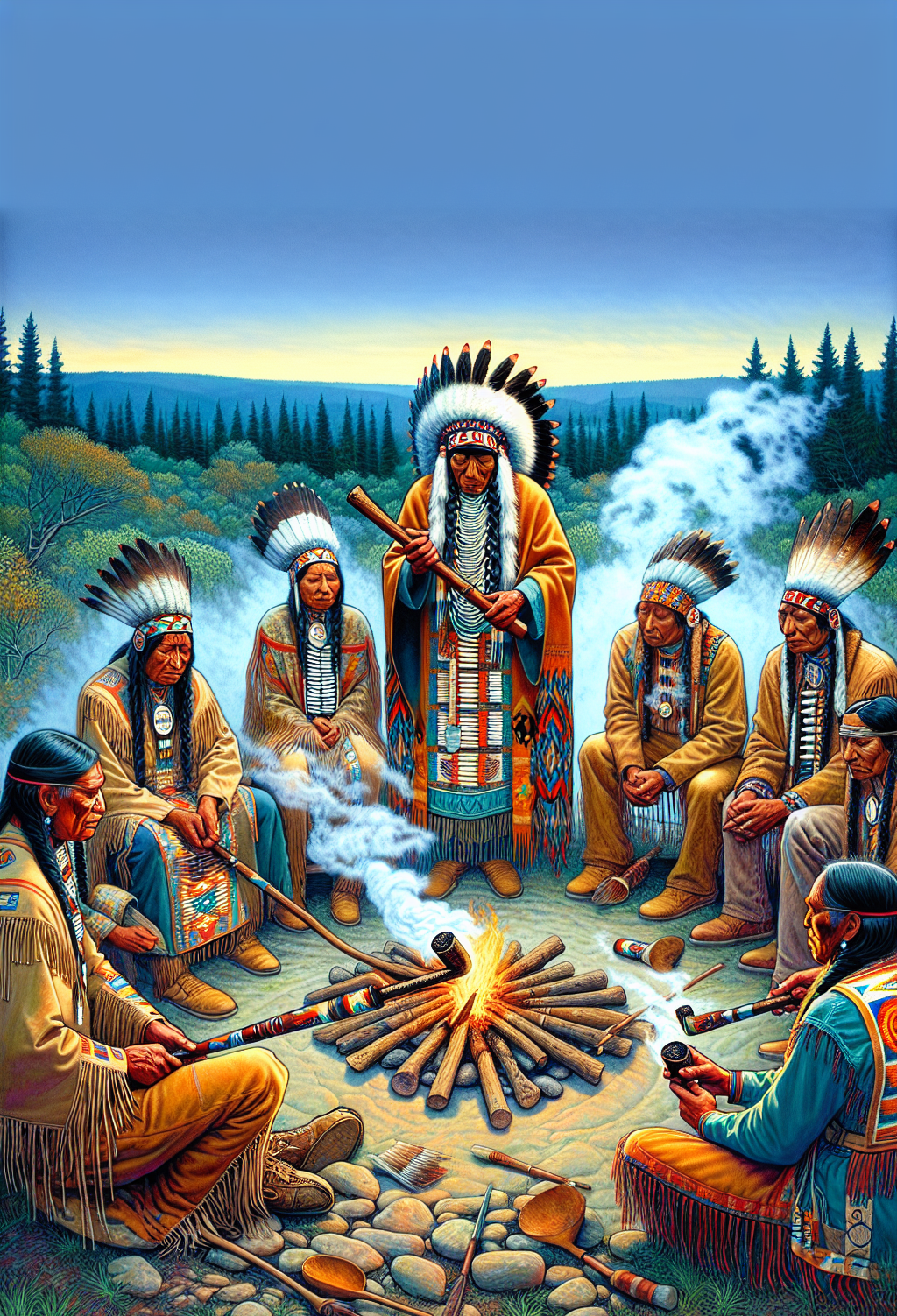 North America - Religious traditions -Sacred Pipe by Tai
North America - Religious traditions -Sacred Pipe by TaiThe Sacred Pipe or Peace Pipe Ceremony is a profound ritual in many Native American cultures, symbolizing a direct connection to the spiritual world. The peace pipe, when smoked, is believed to carry prayers to the Creator, serving as a bridge between the physical and spiritual realms. This ceremony reinforces the spiritual journey and teachings of the tribe.
In Lakota spirituality, the peace pipe plays a vital role in prayer ceremonies, representing the holy power that links all parts of the universe. It is used in significant rituals to summon the presence and blessings of the Creator, strengthening the tribe’s religious beliefs and traditions. The peace pipe stands for unity and connectedness, reflecting the rich spiritual heritage of Native peoples.
The Ghost Dance Movement
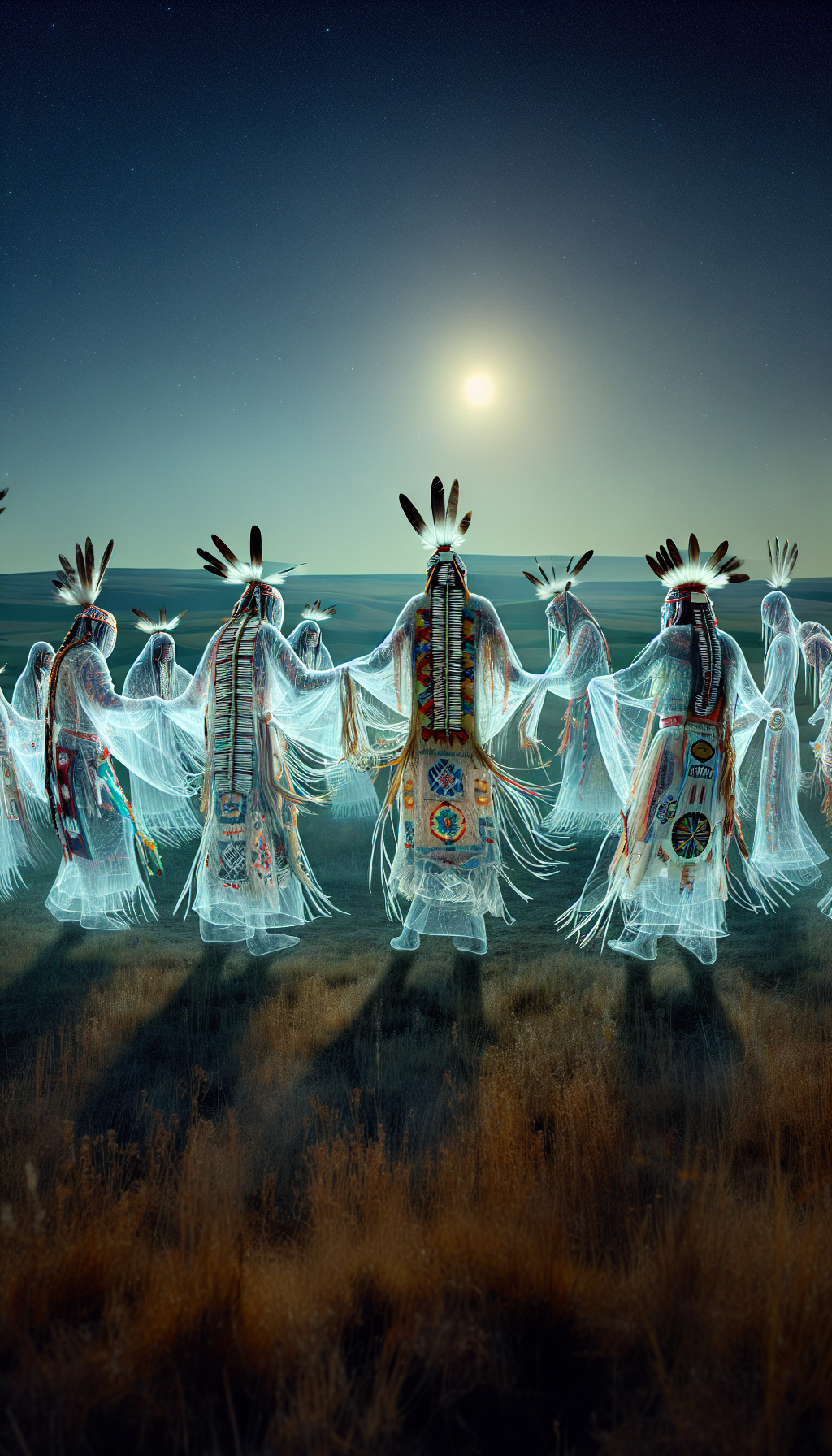 North American Continent - Ghost dance
North American Continent - Ghost danceThe Ghost Dance Movement emerged in the late 19th century as a beacon of hope and spiritual revival among Native Americans. This movement was grounded in the belief that through dance, they could summon the spirits of their ancestors to restore peace, prosperity, and the traditional way of life. It responded to the profound cultural upheaval and oppression faced by Native American tribes during this period.
The Ghost Dance was more than just a religious practice; it was a spiritual and political statement, aiming to reclaim the sacred power and traditions eroded by colonial impacts. This movement highlighted the resilience and spiritual depth of Native American communities, emphasizing their connection to the spiritual realm and their ancestors.
Figures such as Black Elk, a Lakota medicine man and holy man, and Jack Wilson, also known as Wovoka, a Paiute religious leader and founder of the Ghost Dance, played pivotal roles in spreading this movement, reinforcing the importance of spiritual leaders in guiding their communities during difficult times.
Seven Rites of the Lakota
The Seven Rites of the Lakota are a series of sacred ceremonies holding profound spiritual significance for the Lakota people. These rites include the Sun Dance, Crying for a Vision, and other ceremonies, each with its unique spiritual meanings and purposes. These rituals are integral to the Lakota’s spiritual journey, reinforcing their connection to the Creator and the natural world.
Each rite serves a specific function in maintaining the spiritual and social harmony of the Lakota community. For instance, the Sun Dance is a ceremony of renewal and sacrifice, while Crying for a Vision is a personal quest for spiritual guidance and insight. These rites embody the core spiritual faith and practices of the Lakota, illustrating the depth and richness of their religious traditional values.
Native American Deities
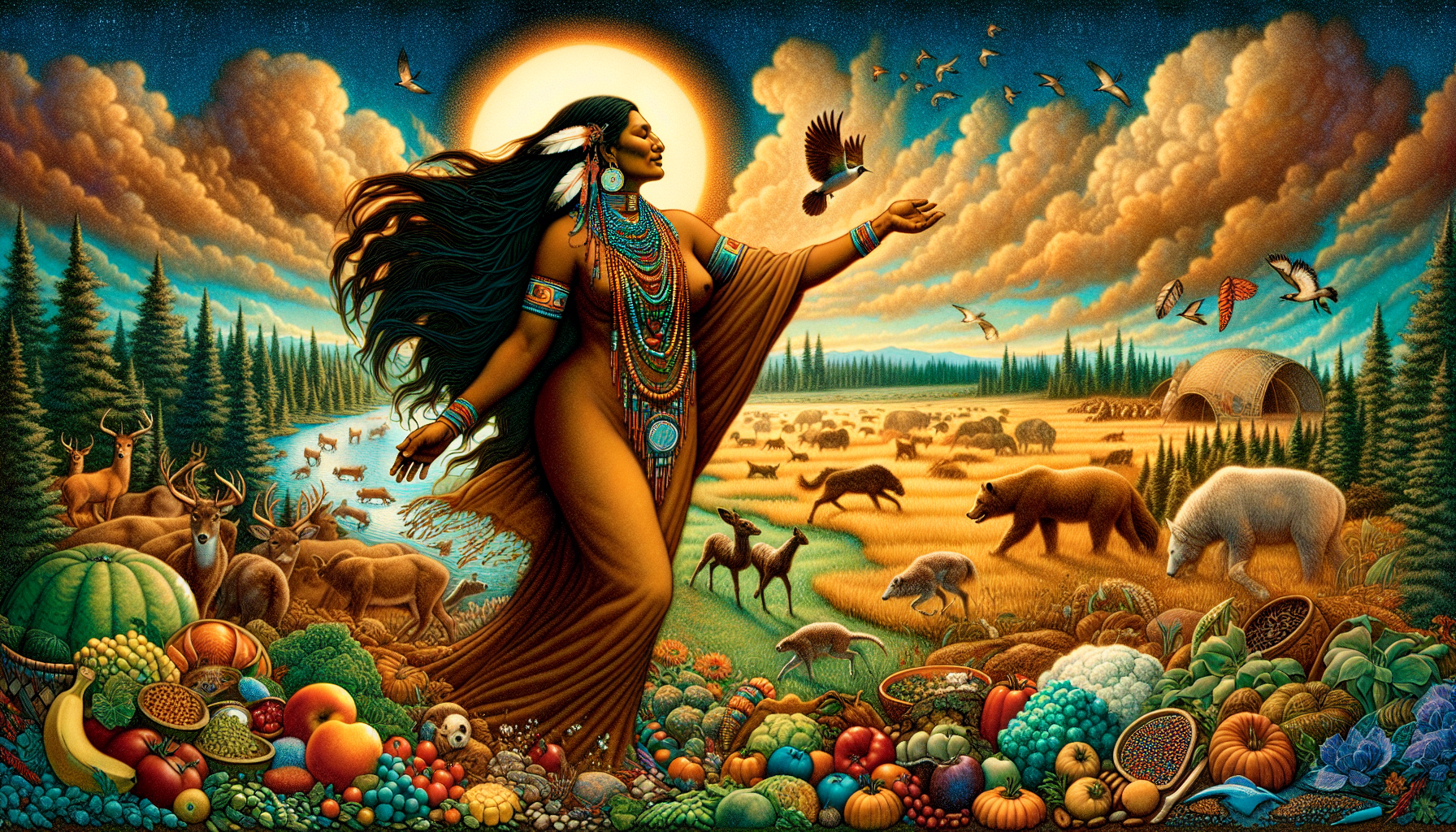 Atira- Mother Earth -Native Religion by Tai
Atira- Mother Earth -Native Religion by TaiNative American cultures are rich with a pantheon of deities, each embodying different aspects of life and nature. These deities are integral to the spiritual fabric of their respective tribes. Many tribes worship a primary creator deity, often seen as the source of all existence and life. In many creation myths, this deity is responsible for bringing the world and its inhabitants into being.
In addition to creator deities, Native American mythology features trickster figures who play dual roles as creators and disruptors. Figures like Coyote or Raven are often central to the tribe’s spiritual teachings, providing lessons on human behavior and the consequences of actions.
Rituals and ceremonies dedicated to these deities seek blessings, guidance, and harmony, reflecting the close relationship between Native American tribes and their spiritual realm. The diversity of deities and their stories across tribes underscores the richness and complexity of their religions and spirituality.
Some Deities:
Atira-Earth Mother
Tirawa-Husband of Atira (Mother Earth) and also associated with the sky
Masaw-Lord of the Dead
Natosi-Sun God
Anpo- Moon Spirit
Sedna-Sea Goddess
Native American Spirit Animals
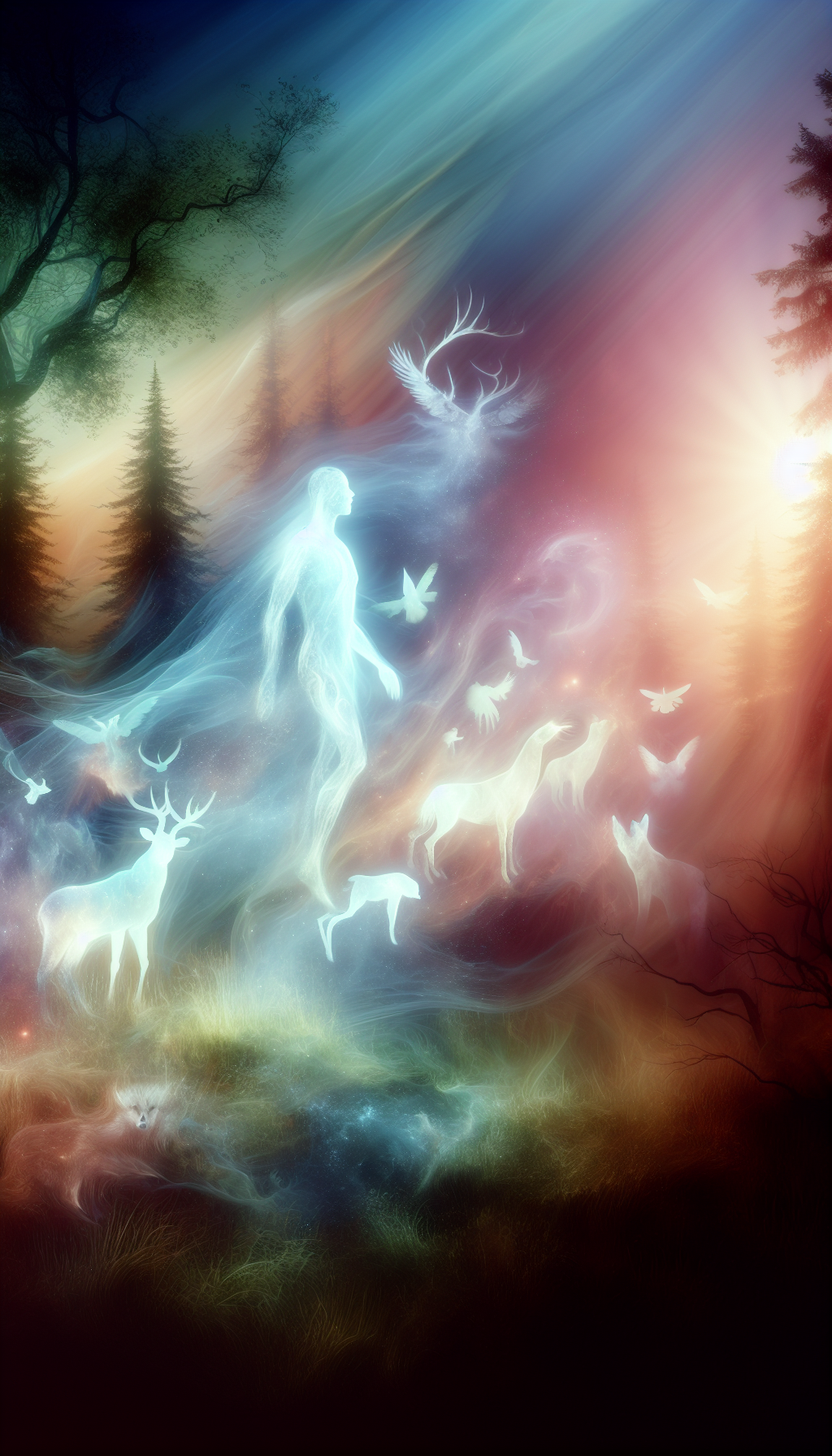 Religious Tradition - Spirit Animals
Religious Tradition - Spirit AnimalsIn American Indian spirituality, spirit animals play a crucial role, serving as guides and protectors throughout an individual’s life. Each person is believed to be associated with nine different spirit animals, each providing specific guidance and wisdom. These animals are identified through natural attraction or repeated encounters, signifying a deep spiritual connection.
The main totem animal is viewed as a lifelong guardian spirit, embodying the individual’s core strengths and characteristics. This totem animal can be represented in various forms, such as totem poles or carvings, symbolizing the person’s spiritual path and teachings. Spirit animals often appear as teachers or guides in dreams or visions, providing insights and lessons to help individuals navigate their lives.
Different tribes have varied beliefs regarding spirit animals, with some not recognizing the concept of totems. This diversity reflects the broader range of spiritual traditions and practices among Native American tribes, each with its unique interpretation of the spiritual world. The significance of spirit animals highlights the profound connection between Native Americans and the natural world, illustrating the depth of their spiritual faith..
Spiritual Leaders and Their Roles
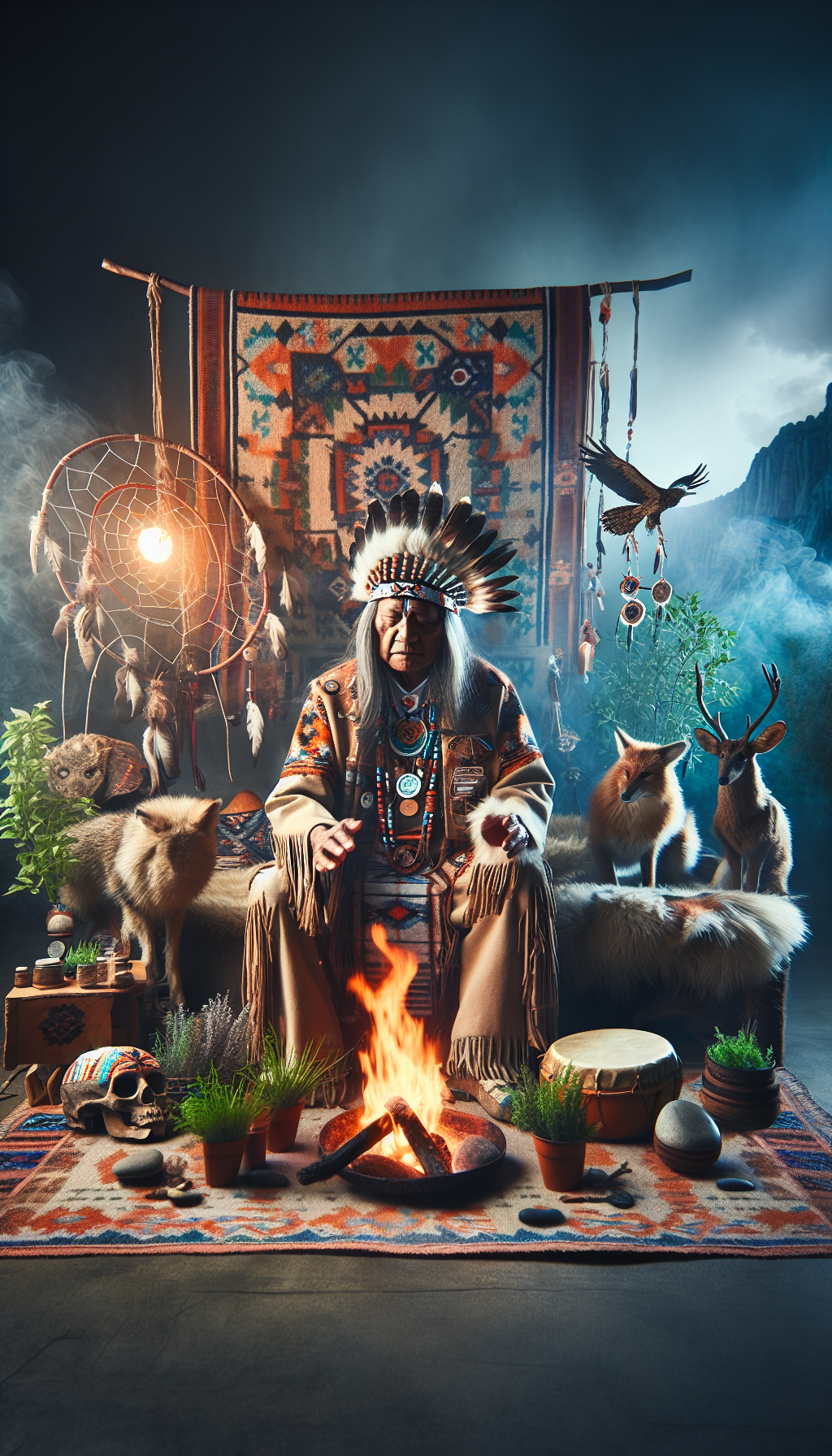 Native American Religion - Shaman or Medicine Man
Native American Religion - Shaman or Medicine ManSpiritual leaders in Native American tribes, often referred to as shamans or medicine men, play a pivotal role in maintaining the spiritual and social structure of their communities. Their key roles include:
- Serving as intermediaries with the Creator
- Helping to preserve and pass down the spiritual teachings and traditions of their tribe
- Conducting rituals and ceremonies
- Offering guidance
- Facilitating communication between the physical and spiritual realms.
In many tribes, spiritual leaders also serve as healers, utilizing their knowledge of herbs, rituals, and spiritual healing practices to treat illnesses and restore balance within the community. Some leaders, known as prophets, emerge during cultural upheaval, offering visions and advocating for a return to traditional practices.
The roles of these leaders are diverse, reflecting the complex spiritual landscape of Native American communities.
Difference between Native American Shaman and South American Shaman
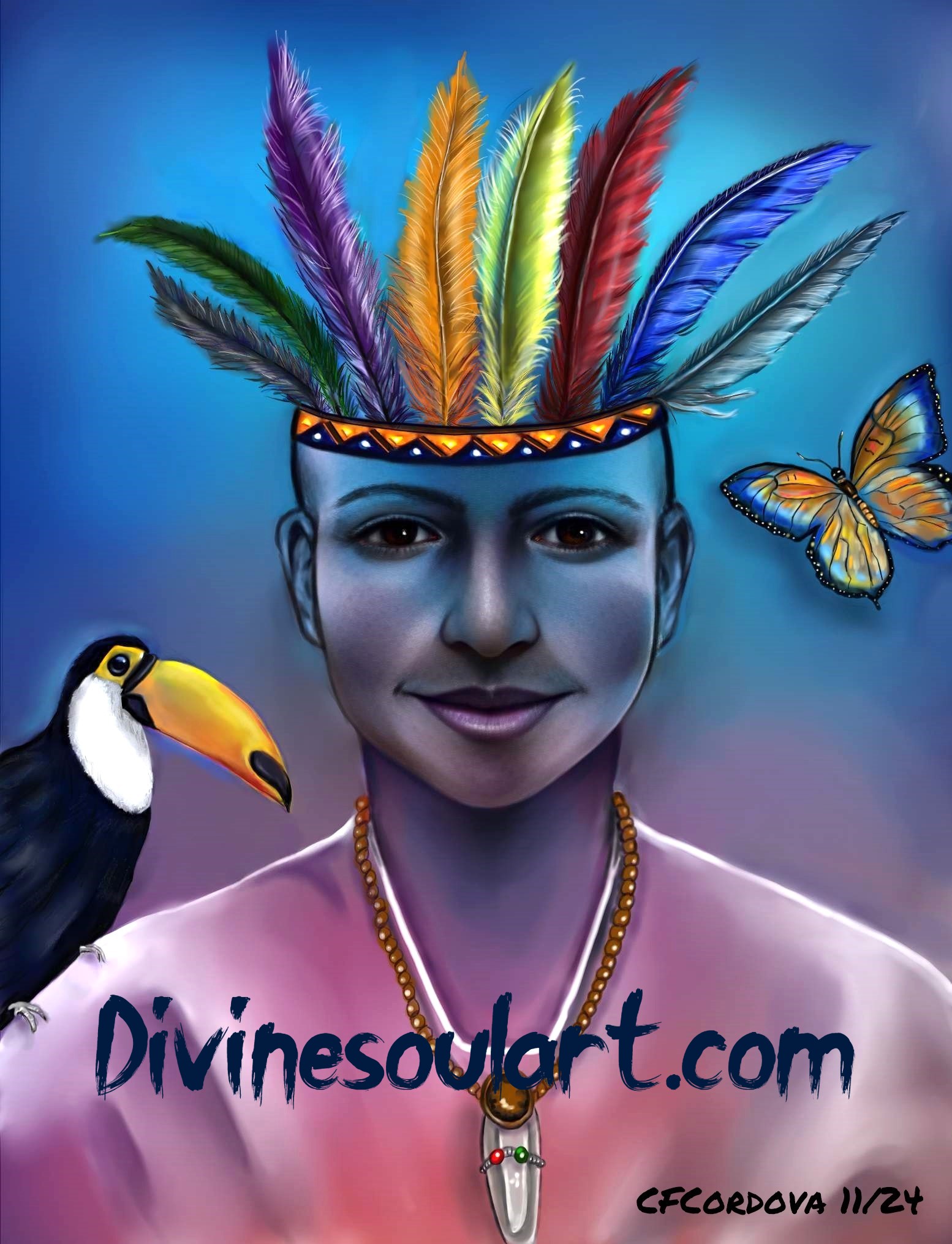 Shaman- South America
Shaman- South AmericaWhile both Native American and South American shamans serve as spiritual leaders, their practices and roles exhibit notable differences. In Native American cultures, shamans primarily focus on community welfare, acting as healers and mediators between the physical and spiritual realms. They often use localized terms instead of identifying as ‘shamans,’ and their rituals are deeply tied to the land and nature, emphasizing harmony and balance.
South American shamans, on the other hand, frequently undergo extensive training, sometimes lasting decades, to master their esoteric knowledge long ago. Their practices often involve the use of psychoactive substances like ayahuasca to achieve altered states of consciousness and connect with the spirit realm.
These rituals tend to be more formal and involve group ceremonies, unlike the often individual practices of Native American shamans. The differences between these shamanic traditions and other indigenous spiritual rituals show the rich diversity of practices throughout the Americas.
Sacred Land and Nature
For many Native American tribes, the land, plant life, and other natural elements are not just physical spaces but living beings filled with sacred power. This deep respect for nature is a key aspect of Native American spirituality, reflecting the belief that all parts of the earth are interconnected and essential for life. Native American wisdom teaches that listening to nature’s rhythms and respecting its balance are vital for sustainability and spiritual health.
The concept of sacred land encompasses specific sites that hold profound spiritual significance for Native American communities. Protecting these sacred sites is crucial for carrying out rituals and keeping their traditions alive without outside interference. The protection of sacred sites is recognized as a human right under international law, underscoring the spiritual connection Indigenous peoples have with their land.
The ‘Seven Generations Principle’ in Native American philosophy urges decision-making that considers how actions will affect seven future generations, emphasizing a duty to the environment. This principle highlights the strong connection Native Americans have with nature, viewing it as a relative to be cared for rather than a resource to be exploited for the country's benefit.
The kinship with nature and all our relations is a core belief in Native American cultures, where everything is seen as part of a larger family, including Mother Earth or Grandmother Earth.
Cultural Heritage and Indigenous Spirituality
Preserving Native American traditions is essential for raising awareness and restoring justice, as these cultures have historically been marginalized. Elders and storytellers play a pivotal role in this preservation by:
- Passing down wisdom and cultural identity through oral traditions
- Serving as a living archive of the tribe’s history, religious beliefs, and cultural practices
- Ensuring continuity across generations
Artistic expressions, like totem poles and intricate beadwork, serve as cultural symbols that convey ancestral stories and spiritual values. Support for Native American communities through ethical philanthropy and cultural initiatives is crucial for sustaining their heritage. By recognizing and respecting the rich tapestry of Native American culture, we contribute to the ongoing vitality of their spiritual and cultural legacy.
Iroquis Spiritual Beliefs
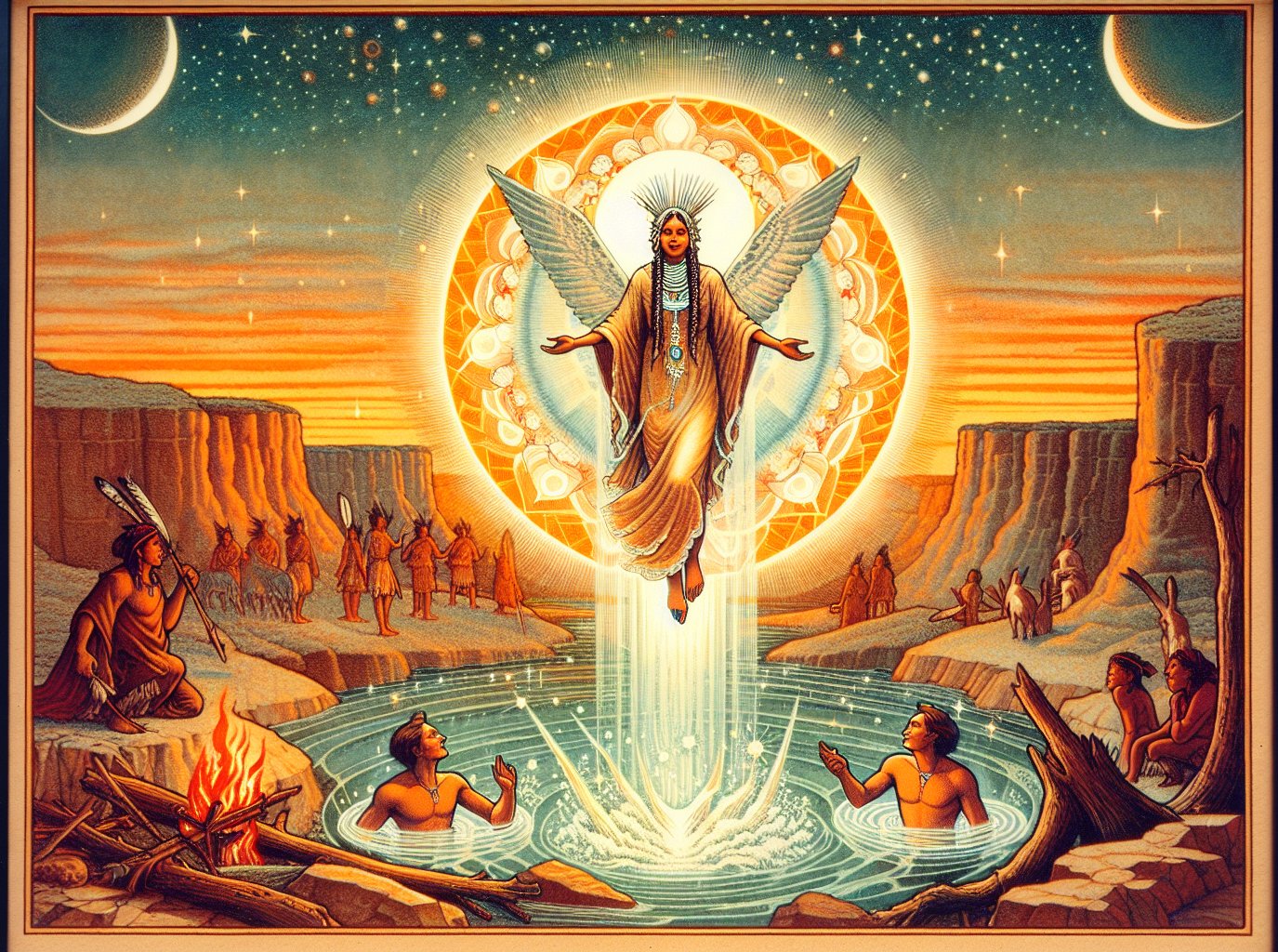 Sky Woman -Native American Religion by Tai
Sky Woman -Native American Religion by TaiThe Iroquois hold a belief in a Great Spirit who is the creator of all living beings, alongside a Good Spirit and an Evil Spirit that govern the outcomes in life. Their creation narrative involves a Sky World and a great tree, with the Sky Woman falling into the water and giving birth to two sons representing good and evil. This duality reflects the Iroquois’ understanding of balance and harmony in the universe.
The Iroquois practice the False Face Society, a healing group that aims to dispel evil spirits using carved masks and ceremonial rituals. Festivals in Iroquois culture often celebrate agricultural events, such as the Corn-Planting and Green Corn Festivals, highlighting the importance of nature in their spirituality.
These ceremonies and beliefs illustrate the Iroquois’ deep connection to the spirit realm and their efforts to maintain harmony with it.
Lakota Spiritual Beliefs
Lakota spirituality is characterized by:
- A profound connection to nature, viewing all elements of creation as sacred.
- The phrase “Mitákuye Oyasiŋ,” which reflects their belief in the interrelatedness of all life and highlights the unity of the universe.
- The sacred hoop, symbolizing the harmony that Lakota people strive for.
Rituals in Lakota spirituality, such as the sweat lodge, vision quest, and the Sun Dance, are intended to achieve harmony and balance. The concept of wakʽą, a sacred energy that exists throughout the universe, fosters a sense of kinship among all beings. These practices and beliefs illustrate the depth and richness of Lakota spirituality, emphasizing their commitment to maintaining balance within the spirit world.
Ojibwe Sacred Beliefs
Ojibwe spirituality revolves around powerful entities called manitouk, which take various forms and hold different relationships with humans. Rituals are essential for maintaining connections with manitouk, often involving offerings such as tobacco. Vision quests are a significant practice, especially for males around puberty, establishing a lifelong relationship with a specific manitou.
Kitche Manitou, meaning ‘Great Spirit’, is recognized as the creator but is not seen as directly involved in human affairs. The Ojibwe also revere the animikeek, or thunderbirds, and Mishebeshu, a monstrous water serpent, both of which play significant roles in their cosmology.
These beliefs highlight the Ojibwe’s holistic view of the universe, where all beings, including animals and plants, possess their own spirits and intelligence.
Spiritual Role of Native American Woman
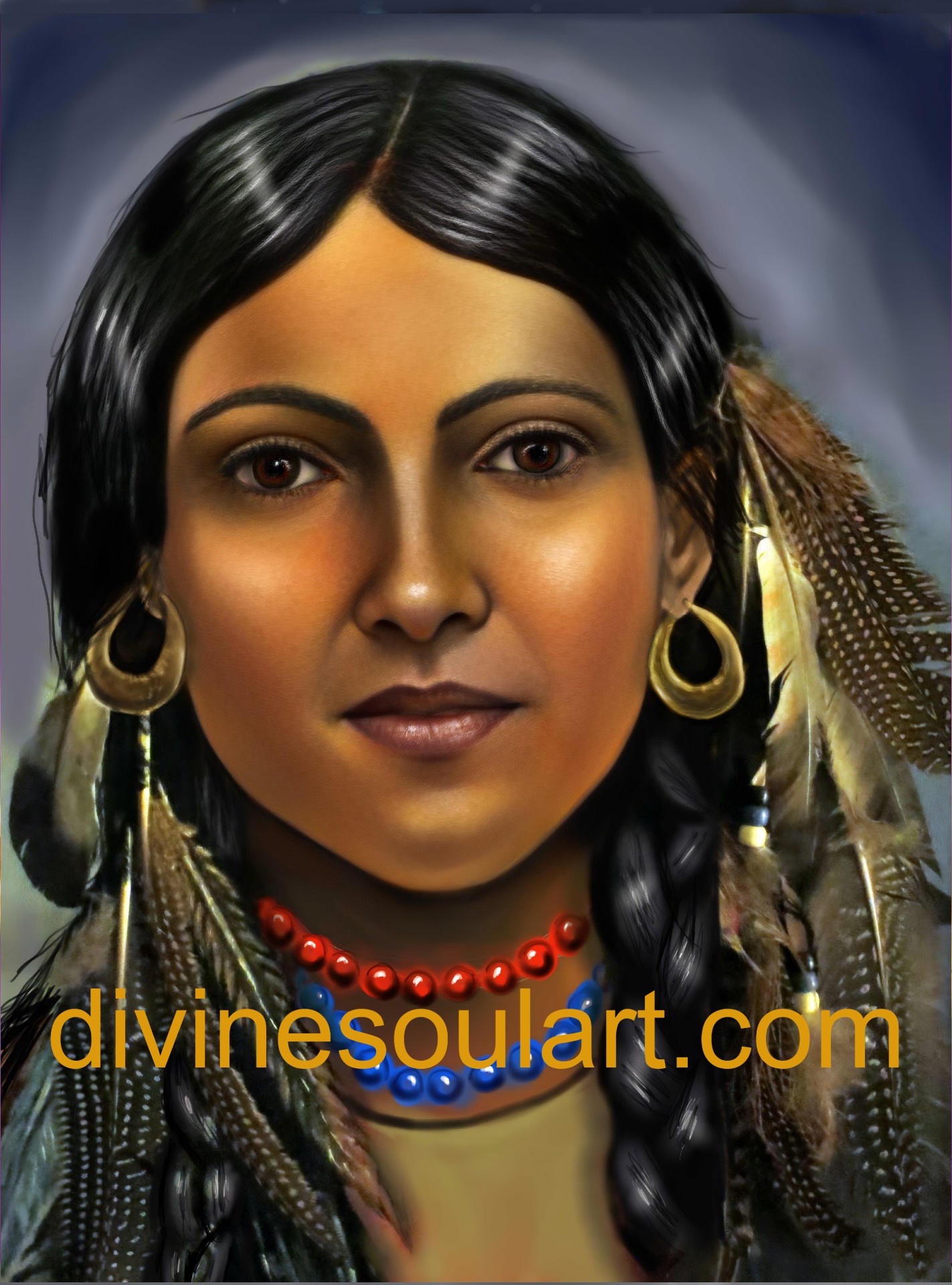 Indian Woman - Native American Religion
Indian Woman - Native American ReligionIn Native American spirituality, women often hold significant spiritual roles as healers, shamans, and keepers of cultural traditions. They contribute to the spiritual and social fabric of their communities, ensuring the preservation and transmission of traditional beliefs. Women’s roles in spirituality are diverse, reflecting the varied practices and beliefs across different tribes.
The White Buffalo Calf Woman is a central figure in Lakota spirituality, symbolizing the sacred and transformative power that women hold. Women in many tribes are responsible for:
- Conducting important ceremonies
- Maintaining sacred objects
- Passing down spiritual teachings to future generations Their contributions are essential for the continuity and vitality of Native American spiritual traditions.
Interaction with Other Cultures
The historical interactions between Native Americans and European settlers were marked by significant cultural exchanges and misunderstandings. Native peoples adopted European goods, while Europeans learned survival techniques from Indigenous peoples. However, these interactions often led to conflicts, particularly over differing perspectives on land ownership and spirituality.
The Ghost Dance emerged as a response to colonial oppression, aiming to restore Native American lands and way of life. This movement highlighted the resilience and spiritual depth of Native American communities, emphasizing their connection to the spirit world and their ancestors.
Despite the cultural clashes, these interactions have shaped the spiritual landscape of indigenous people and Native American tribes, reflecting a complex history of adaptation and resistance.
Misconceptions and Respecting Native Beliefs
Many misconceptions about Native American spirituality stem from historical stereotypes and a lack of understanding. Media portrayals often oversimplify their rich and diverse traditions, leading to the erroneous belief that Native American spirituality is solely about magical practices. In reality, their spiritual faith encompasses a wide variety of practices across different tribes, each with its own unique traditions.
Participating in Native American rituals or learning about them should be approached with respect, recognizing their significance within their original cultural context. It’s essential to understand that spirituality among Native Americans often intertwines with daily life, challenging the stereotype of a distinct religious practice reserved for special occasions.
Respecting Native American beliefs involves acknowledging their depth and complexity, as well as appreciating the spiritual heritage that continues to thrive today.
Summary
Native American spirituality is a rich tapestry of beliefs and practices that reflect a deep connection to nature, the spirit realm, and the Creator. From the core concepts of interconnectedness and sacred power to the diverse rituals and ceremonies that define their spiritual path, Native American tribes offer a profound understanding of the universe and our place within it. The roles of spiritual leaders, the significance of spirit animals, and the contributions of women all highlight the complexity and depth of their spiritual traditions.
Understanding and respecting the Native American history of spirituality requires acknowledging the historical context and the resilience of these communities in preserving their cultural heritage. By appreciating the diversity and richness of their spiritual faith, we can foster a deeper connection to the wisdom that Native American peoples have to offer. Let us continue to embark on this journey with an open heart and mind, acknowledging the enduring legacy of Native American spirituality and its continued relevance in our world today.
Click below and views more than 600 pieces of spiritual artwork

Spiritual Books
If you enjoy the articles on this website, you will also appreciate the short stories in the books below. Click here and continue the journey.
